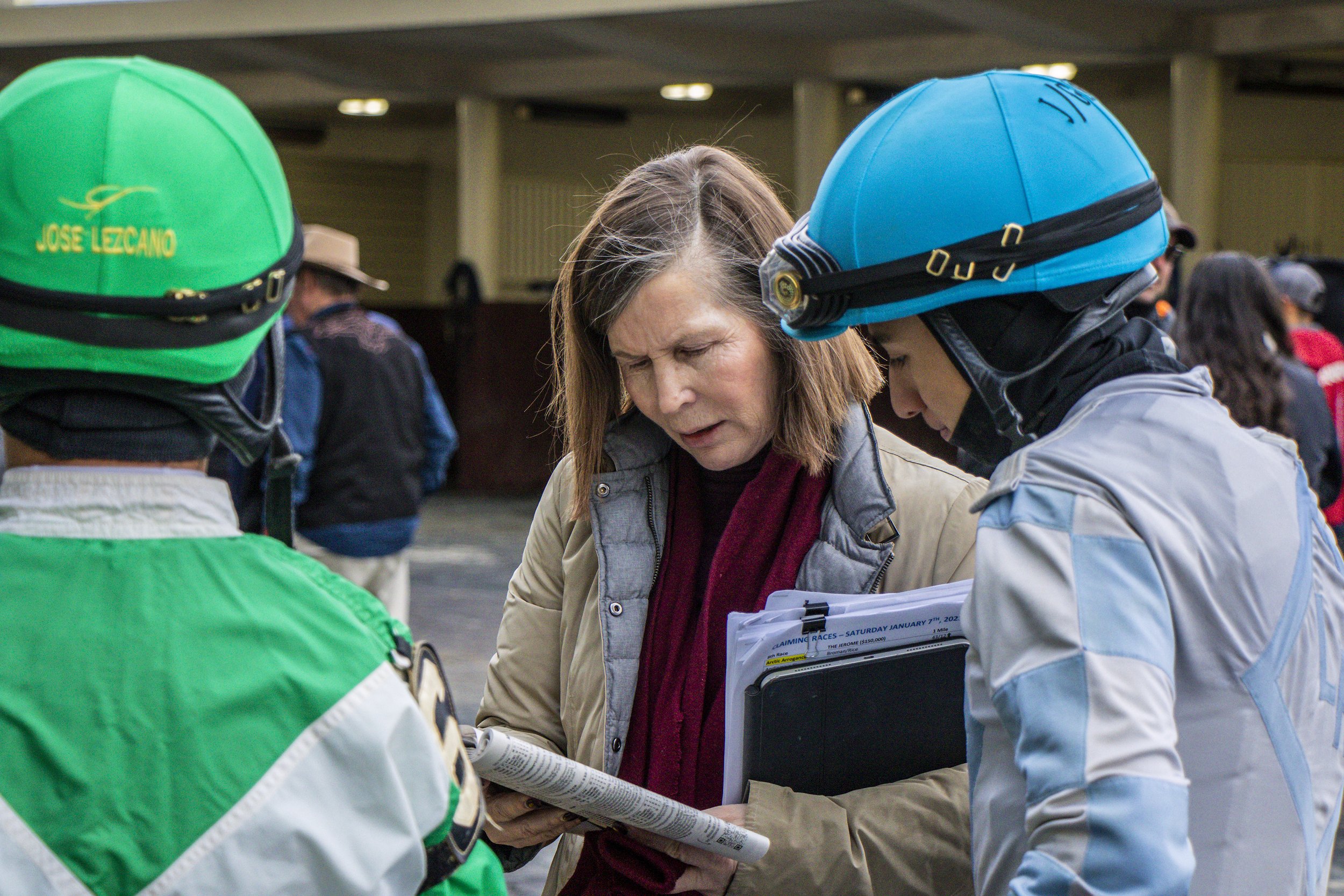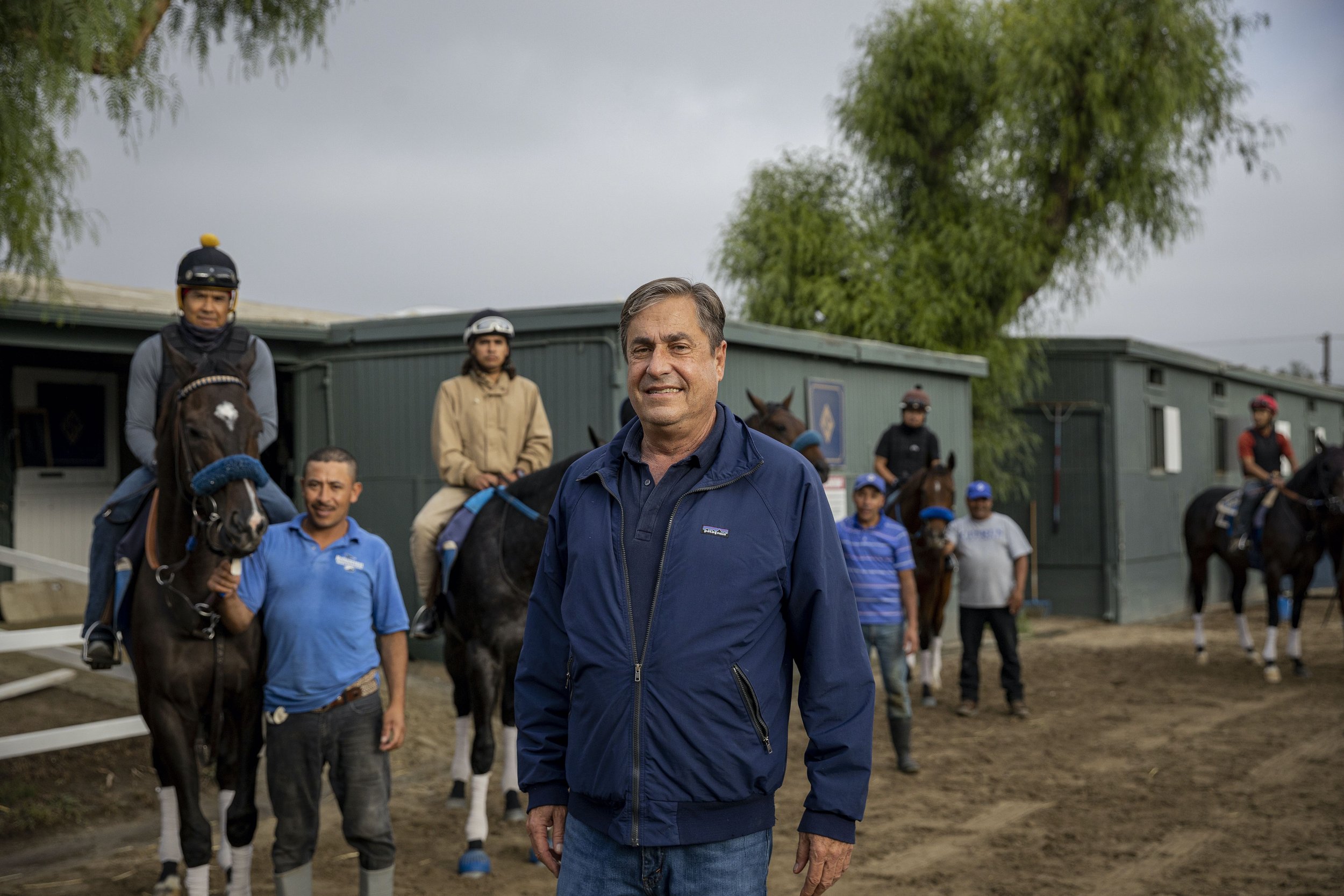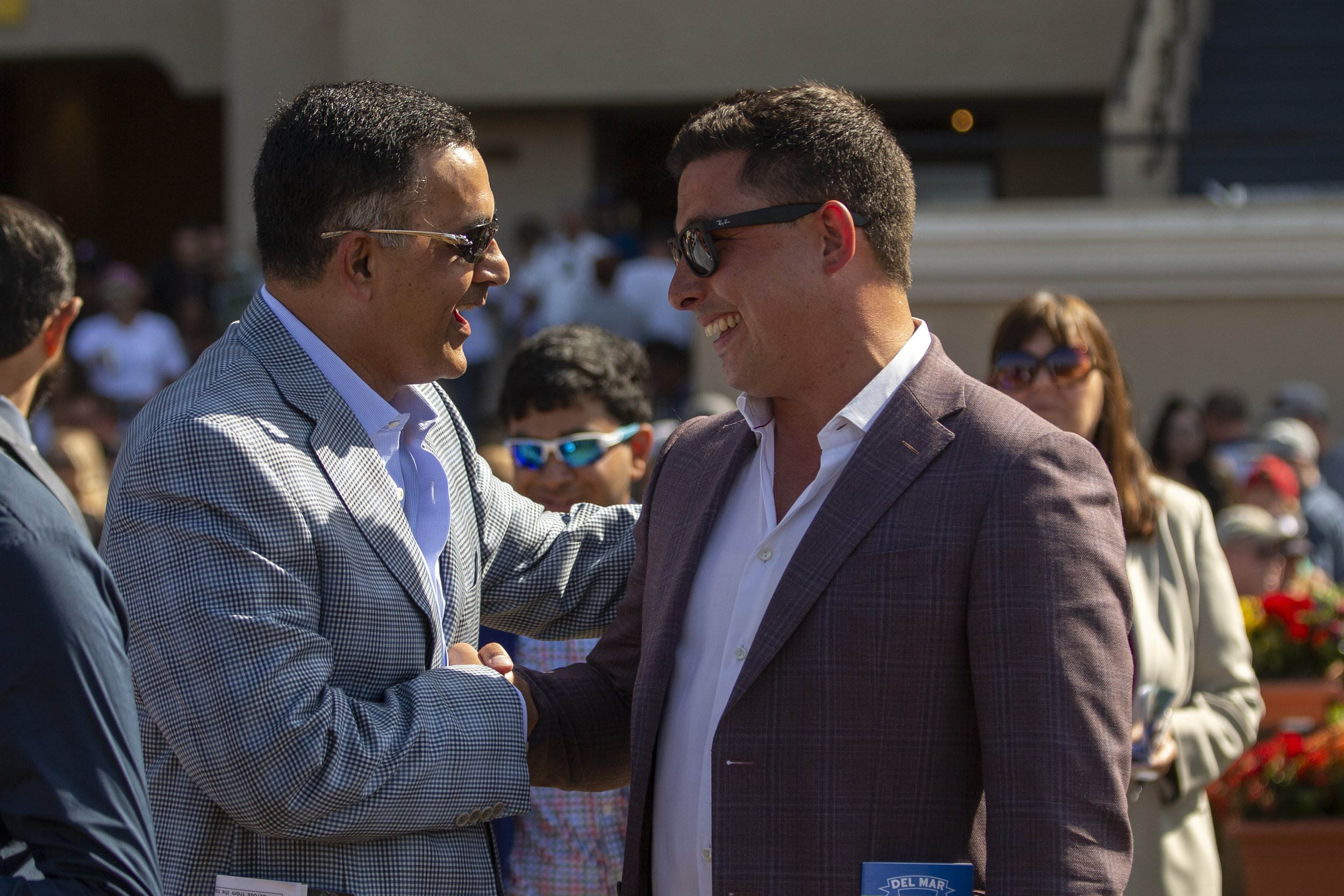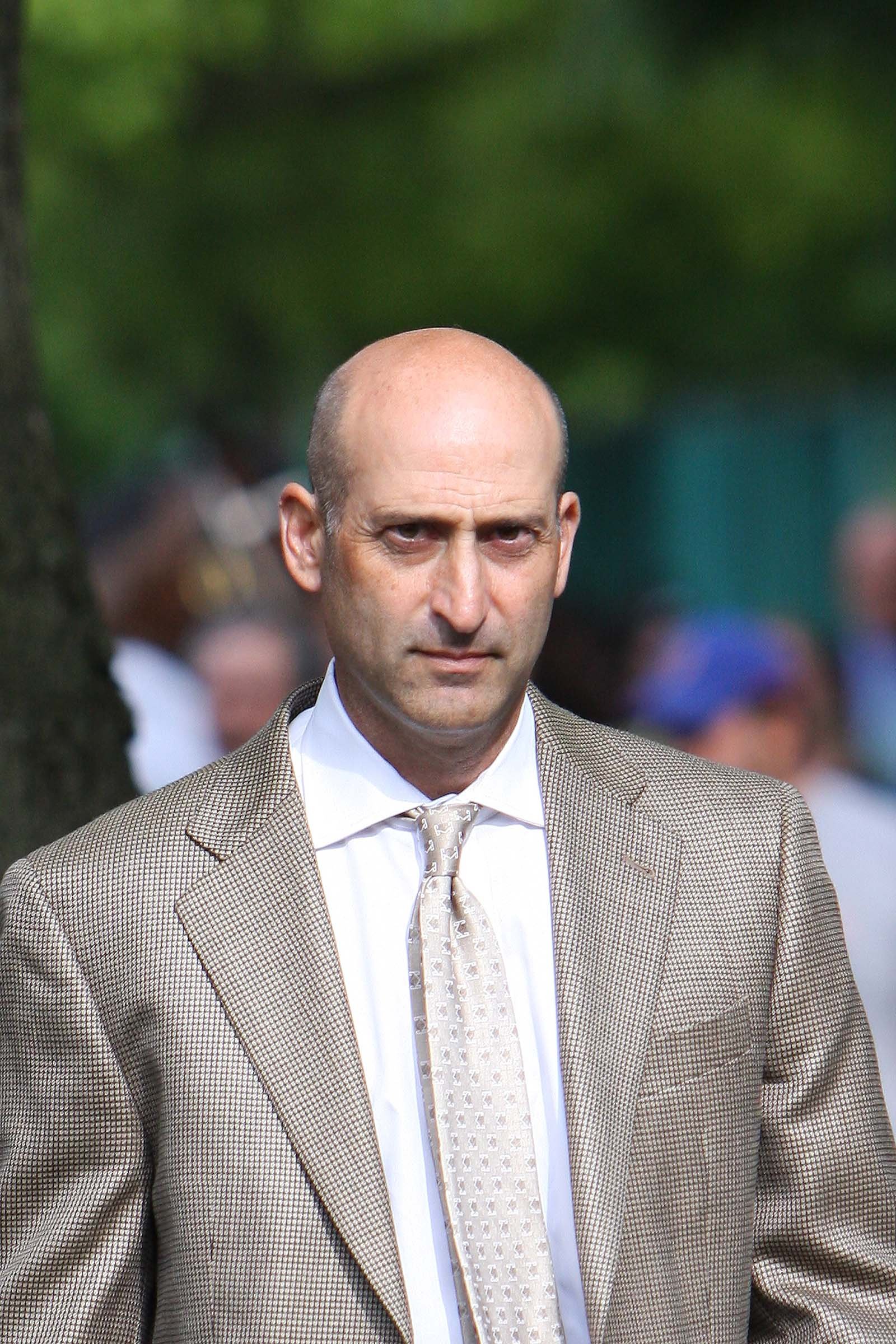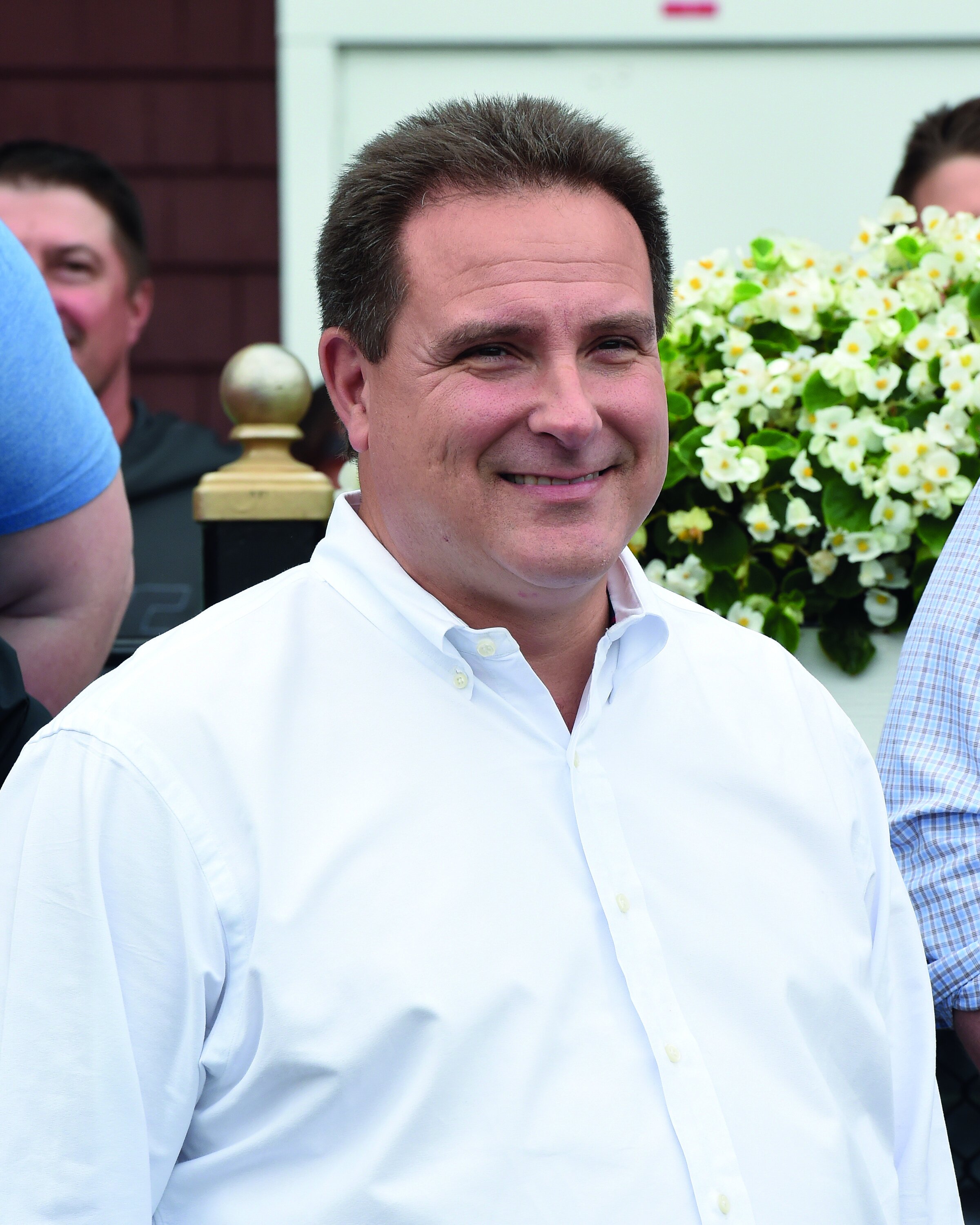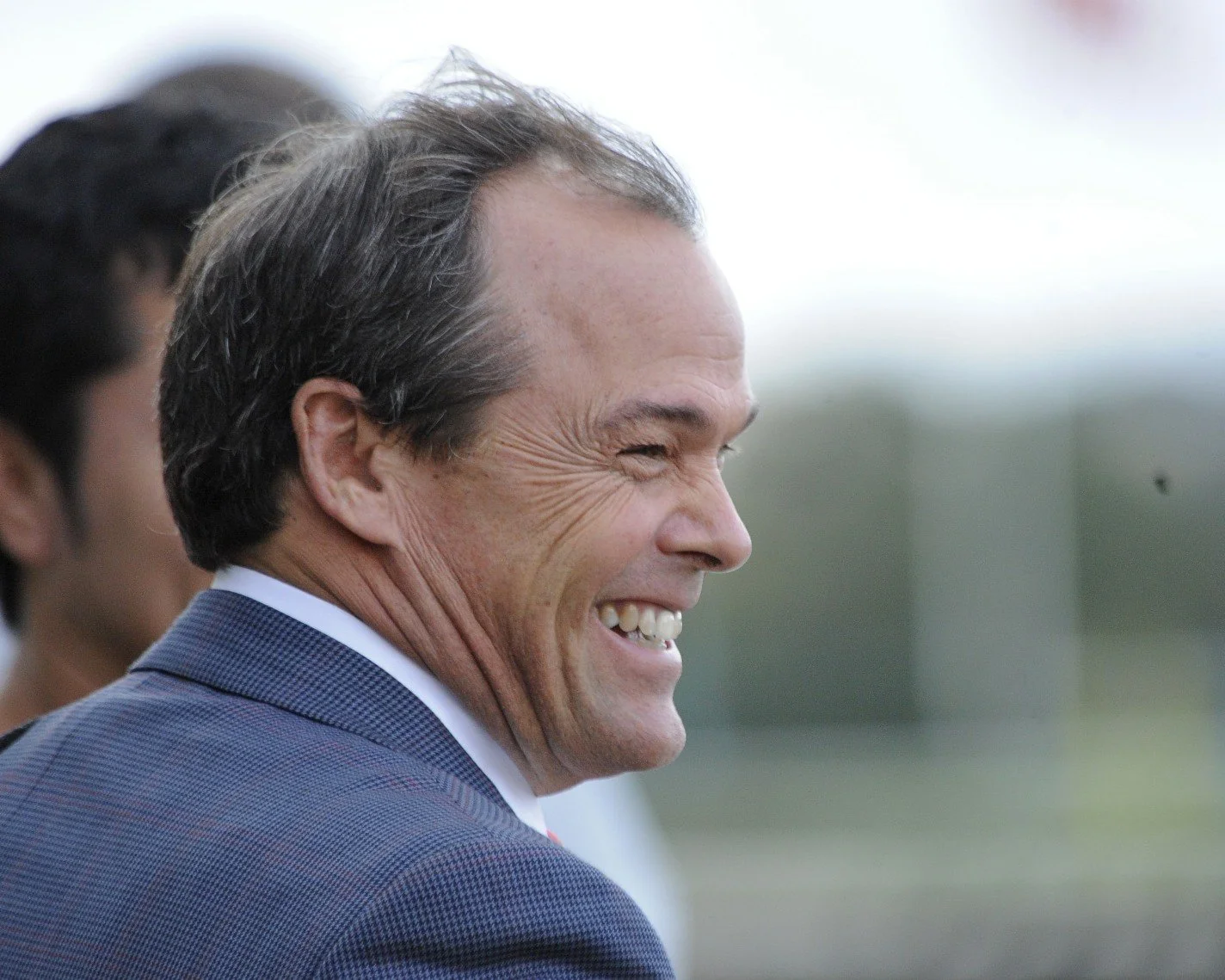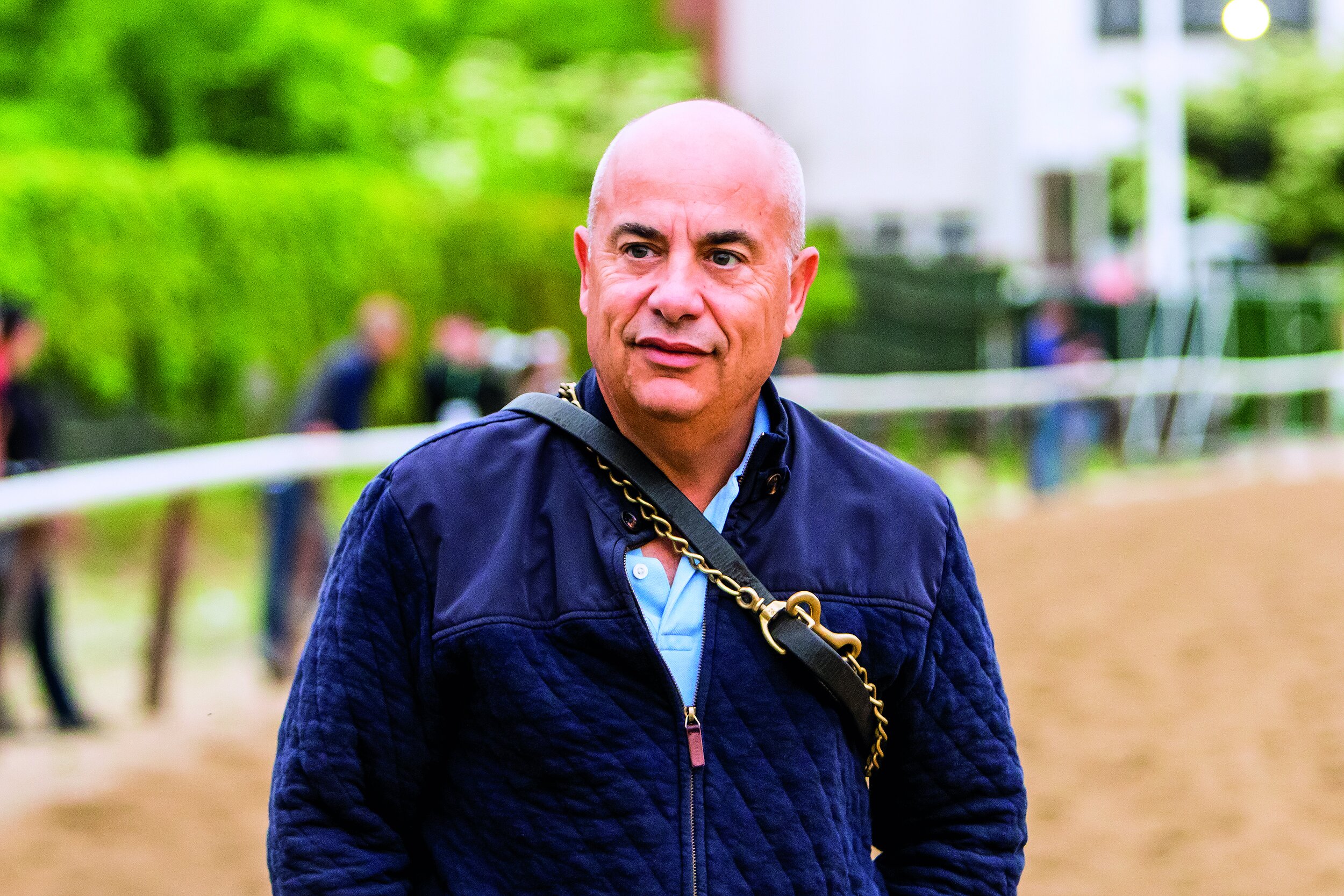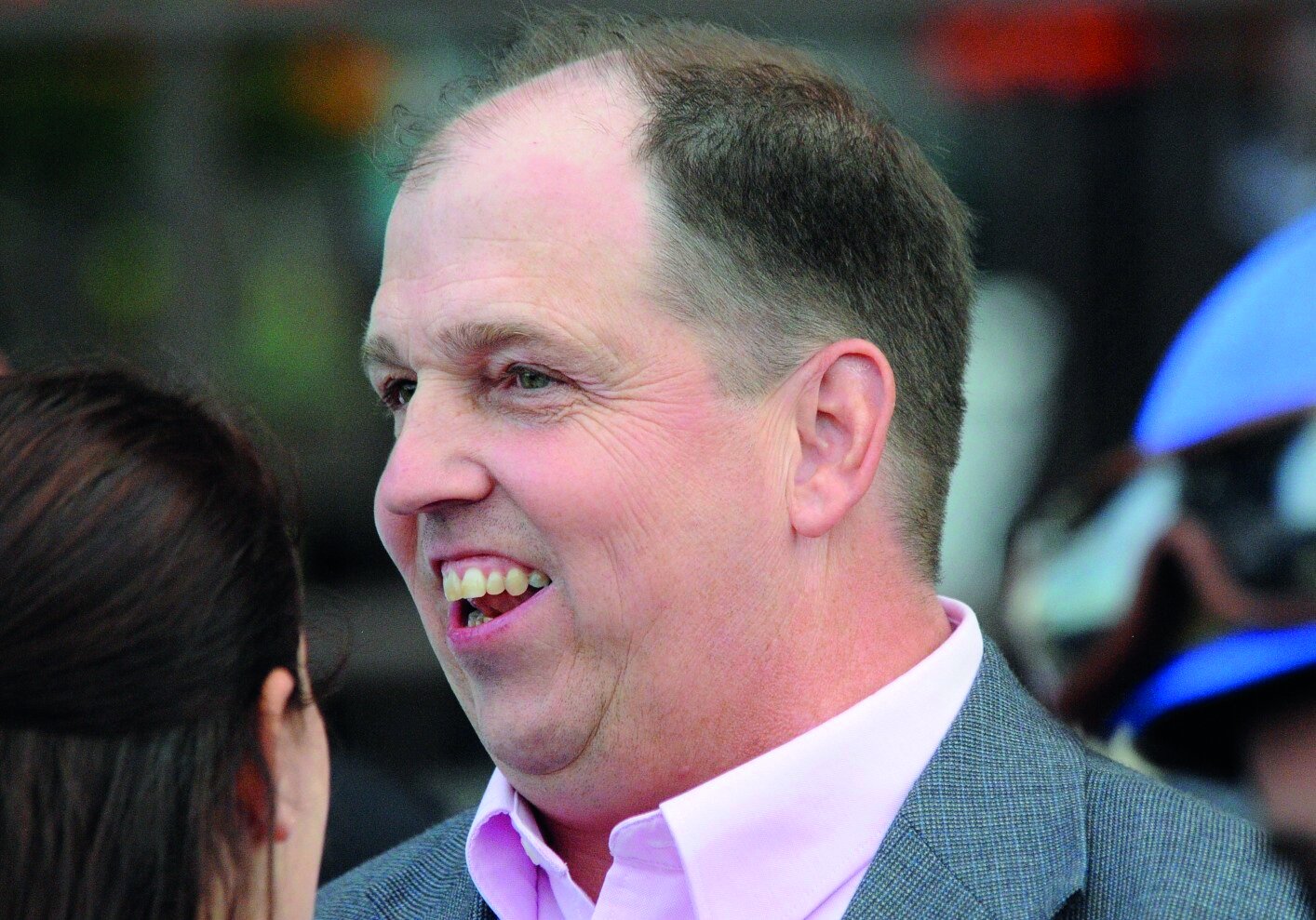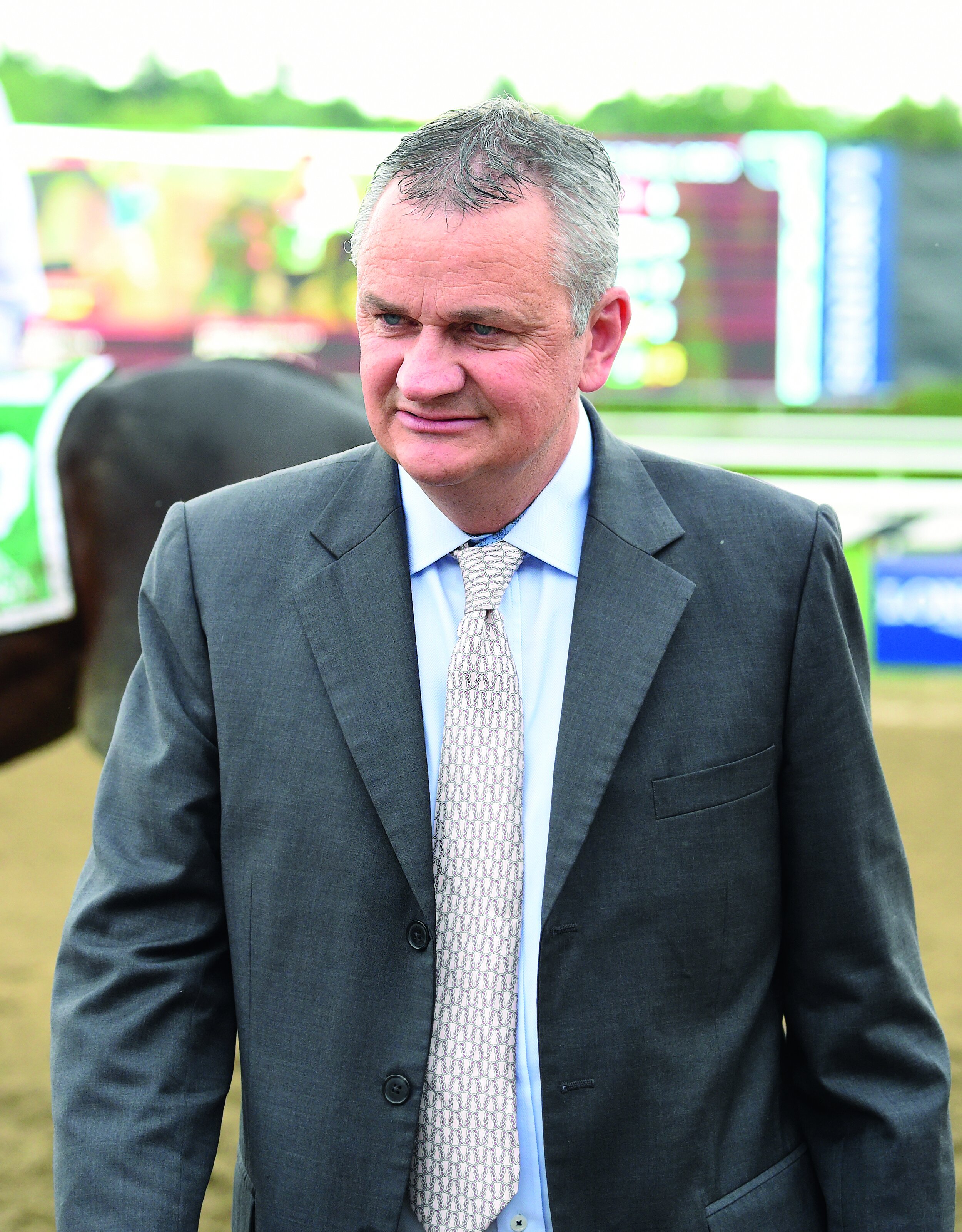#Soundbites - Which other trainer do you most admire on the backstretch, and why?
Article by Bill Heller
Bret Calhoun
Brendan Walsh
Wayne Lukas never ceases to amaze me. He’s out there every morning. He’s at the sales and still competing at the highest level. He’s a guy that amazes me.
Brendan Walsh
There are a lot of trainers on the backstretch that I admire for different things. Some are good with stakes horses. Some of them are good with young horses. There’s almost too many to mention. I don’t really want to name one.
Todd Fincher
The ones I admire the most are the ones who started in the grass roots and worked their way up and became successful. Most of those guys have a true love of horse racing. It’s not an easy profession. It’s an unending job. Those guys that fought through adversity are the ones that I admire most.
Peter Miller
There are a lot of them I admire. Here in Southern California, I admire Richard Mandella and John Sheriffs because they limit the number of horses they take. I can’t do that. I’m a horse junkie. I admire Brad Cox and Steve Asmussen because they run such a huge operation with success at all levels. That shows a lot of organizational skills as well as horsemen skills. They also know how to delegate. I don’t even know how they do it. You can also throw in Todd Pletcher and Chad Brown. I’m at 80 horses, and I’m at my wit’s end!
Gary Contessa
That is a no-brainer: Wayne Lukas. He revolutionized the entire racing industry, and people took his lead. He came to the East Coast, and he showed us how to talk to clients; showed us how to develop young horses; and showed us what a barn should be like. Look at the history. What trainer in America has developed more good trainers than he has? Nobody. He’s developed horses and people.
Ron Moquett
There’s a lot of people you admire for different reasons. Probably the older guys like Bernie Flint, Jinks Fires and Wayne Lukas. They’re forever evolving. To be involved in this business for so many years and compete at a high level, it’s impressive. They do it year after year.
Larry Rivelli
Larry Rivelli
Wesley Ward—because he’s one of the very few jockeys that have become successful trainers. A lot of them tried and failed. He didn’t. He’s at an elite level.
#Soundbites - What do you look for when you evaluate a yearling at sales, and are there sire lines that influence your opinions?
Linda Rice
Linda Rice
I look for a good shoulder, and usually that will transcend into a great walk, an athletic walk. I do that for the length of stride. I like to buy young mares. Of course I have preference for some stallions I have had success with like City Zip. And then stallions everybody likes: sons of Into Mischief, sons of Curlin, sons of McLain’s Music. I’ve done well with them. If they have a great shoulder and a great walk, I’ll take a shot on an unproven stallion.
Brad Cox
The first thing, from a physical standpoint, is you have to consider his size. Is he too big or too small? As far as sire lines, you’re looking for signs. You totally have to have an idea what the yearling will look like. Will he look like his sire? You pay attention.
Graham Motion
Graham Motion
I think many of us get influenced by stallions’ progeny that we have trained before. There are other ones that we avoid if we haven’t done well with a sire’s prodigy. I think the one thing I look for is athleticism in general. I’m not overly critical of conformation.
John Sadler
John Sadler
We’re looking primarily for dirt pedigrees for California. I have a good idea what works here, what doesn’t work here. Obviously, I’m partial to some of the sires I trained, Twirling Candy, Accelerate, and Catalina Cruiser who’s off to a very fast start. On the conformation side, I look for a well-conformed horse that looks like an athlete. As an experienced trainer, you look for any little things. You learn what you can live with or without. Then, obviously, I’m looking for Flightlines in a couple of years!
Simon Callaghan
Simon Callaghan
Generally, I’m looking for an athlete first and foremost. Conformation and temperament are two major factors. Yes, there are sire lines I like—not one specific one. Certainly it’s a relatively small group.
Tom Albertrani
Tom Albertrani
I’m not a big sales guy, but when I do go, I like to look at the pedigree first. Then I look for the same things as everyone else. Balance is important. I like to see a horse that’s well-balanced, and I like nicely muscle-toned hindquarters.
Michael Matz
One of the things, first of all, is I look at the overall picture and balance. We always pick apart their faults, then what things that are good for them. You look for the balance, then if they’re a young yearling or an older yearling. Those are some of the things I look at. If you like one, you go ahead. There are certain sires if you have had luck with them before. It all depends on what the yearling looks like. I would say the biggest things I look at are their balance and their attitude. When you see them come out and walk, sometimes I like to touch them around the ear to see how they react to that. That shows if they’re an accepting animal.
#Soundbites - How closely do you follow your veterinarian’s advice if it conflicts with your gut feeling about your horse?
Article by Bill Heller
Bruce BrownThat’s a good question. I usually have a good enough relationship with my vets. I really trust their judgment. It seems like nowadays there aren’t many vets who would do something you don’t want, something that you really don’t need, whatever it takes to get a horse in a race. That’s not in our game anymore. I have in my head what I think, but usually it matches well with my vets.
Kelly BreenI probably use a vet’s recommendation, maybe 85 percent of the time. I have gone against their recommendation because of my gut. Usually, my gut is the right answer. For sure, there are times when my gut is wrong. But sometimes the scientific answer is not always correct. Generally, the advice given from the vet is the textbook version, and not everything is textbook in horse racing.
Charlie BakerWell, if it conflicts with my gut feeling, percentage wise, I would say 65 percent I’d follow the vet. It all depends on the situation. Is it one I’ve dealt with in the past? If so, I would use my experience, especially if it’s a younger vet, one fresh out of school. If I’m totally confident in my vet, I listen to him.
Carla GainesThat’s a good question. You always want to do what’s best for the horse. You kind of have to go along with the veterinarian. These days, with just being way more cautious—not that it was irrelevant before—if you have a gut feeling that a horse is fine, you still do diagnostics to make sure your horse is fine.
Ian WilkesIan Wilkes
You talk to him. Common sense prevails.
Burl McBrideI stick with my gut feeling, but I do trust my vets because I can’t see an X-ray. I can’t see an ultrasound. I’m pretty opinionated. These horses will talk to you if you listen.
Leonard PowellA lot of times, I would use the vet for a sounding board. I’d really consider his opinion. Ninety-ninety percent of the time we come to a consensus.
Tom ProctorI don’t ask a veterinarian for advice. I have a license. They have a license.
#Soundbites - if you ran racing, what would you do?
Article by Bill Heller
Kenny McPeek
Kenny McPeek
I’d make it easier for fans to watch. I just think it’s very difficult. You have to open an account or have a credit card or get a satellite dish. The restrictions are constricting our ability to grow the sport. If you don’t live in one of 38 racing starts, [you] can’t open an ADW account. We make it too difficult for the fans.
Tom Amoss
Wow. I would make mandatory, random blood testing for all stables and barns; and I would do that immediately. What I’m saying is that the problem with racing today is we only test on race day. We’re not catching people who break the rules. We have to test the barns other days.
Kathleen O’Connell
Kathleen O’Connell
Stop the overkill with rules and regulations. Some of them don’t even make sense. The federal government stepped in. It’s too much. It needs to be more organized and organized by horse people. Say a horse ships in to me from another state. The racetrack wants the serial number for the vaccine from the other state. Some of these things are impossible. It’s just going to cause more trauma. The other thing is that licensing has become so difficult for owners. Fingerprints from every state. It puts a damper on things. My owners are not happy with the bookkeeping system. They’re chasing people from the business by putting a bad taste in their mouths. I would definitely change that.
Jamie Ness
That’s a tough one. Obviously, the horses come first. To me, the bettors and the owners are the people who put this sport on. These are the people we have to take care of. I think we’re regulating ourselves out of business—more rules, more rules, more hoops. And the people holding the bag are the owners and the trainers. I have a couple new owners. The license process is difficult. They can’t claim a horse if they haven’t run one. How do they get into the business?
John Servis
John Servis
Wow. I think I’d have to hit the lottery to afford doing everything I wanted to do. Random testing across the board. I think I would try to make it a little bit more friendly for the fans: less takeout, maybe some more gimmicks. They seem to be doing very well.
Al Stall
I would make adjustments according to the declining foal crop. It seems like horse populations are getting cannibalized by overlapping races and overlapping dates. It’s simple math. Twenty-five years ago, we had close to 30,000 foals; and now we’re below 20,000 roughly. That would help the horses, which is the most important thing; then the horsemen and owners.
Mitch Friedman
It’s a good question. I would listen to the horse people—ask trainers for their opinions more. Ask the trainers what you think of the track every day. I would give more input to people who are on the backside every day with the horses. More input for exercise riders, grooms, clockers and vets, every day. Then meet every week with management and have them discuss that.
#Soundbites - How much do you rely on veterinarians’ input for day-to-day decisions?
By Bill Heller
Mark Hennig
I wouldn’t say I rely on them on a day-to-day basis. We evaluate horses after a workout. But day to day, there seems to be a horse we want to look at. If a rider has any kind of negative comment, we make a point of going over those horses at the end of the morning. And we also go over the previous day's workers. We do have vets if there is a soundness issue or a horse needs scoping.
Tim Hills
I’m married to a vet, Laine, so I very much respect their opinions. I’m not old-school. They only get a vet when the horse is near death.
Ron Moquett
Very little after what I’ve seen over the years. When I first started, the vets and blacksmiths weren’t allowed on the track until after the break. I use them for preventive stuff, taking care of the joints, because we’re asking these horses to do strenuous things. Other than that, I don’t rely on them at all.
Bret Calhoun
We use them when things get beyond our control—things like X-rays, ultrasound, scoping, things like that. Obviously we depend on them quite a bit for that. As far as day to day, we know our horses better than them. We see them every day. When there’s a change in them, obviously I bring them [vets] in for consultation. We use them for routine stuff like Lasix medications. Other than that, we don’t use them that much.
Mike Maker
Basically, we use a veterinarian as far as illness and lameness, and that’s about it.
Cliff Sise Jr.
I go over the horses myself pretty good. But sometimes a veterinarian’s suggestions are good, too. We have to rely on them in California. They check them for workouts; they check them for races. So we rely on a good vet.
Mark Glatt
How much do I rely on them? Because of the rules now, the veterinarians are heavily involved. Most of these horses are checked twice a week.
Eoin Harty
It all depends. You might go through a period where you only have a vet come to scope or vaccinate a horse. Then you go through a rash of bad luck, and you might have a veterinarian come for seven, eight days in a row. But the more experience you have, the less you rely on veterinarians. You see so much over the years. You can’t buy that education.
#Soundbites - What would you do if you weren’t training Thoroughbreds?
By Bill Heller
Mike Trombetta
Mike Trombetta
That’s a heck of a good question. I’ve been doing this so long, I couldn’t tell you. I really don’t know. Construction and demolition, that would be an option. I did that for 15-20 years, but I was doing this at the same time, too. I like this a heck of a lot more.
John Kimmel
John Kimmel
There are two things besides horses I love: snow skiing and deep sea fishing. I’m in Utah, skiing right now. I’m not that far from retirement. I’ve been doing this for 40 plus years. When things tail off, if my business slows down, that’s what I would be doing.
Mark Casse
Mark Casse
I’ve thought about that many times. Probably real estate. I just think it’s a challenge, and the rewards are great. That’s what I would probably do.
Jeremiah Englehart
Jeremiah Englehart
Oh, wow! I’m not sure. I’ve been doing horses since I was so young; I always wanted to be a trainer. I guess I would like to do something with football. I’ve always had a passion for football, maybe coaching or working with kids. I’ve always been a fan in sports. I played sports in high school. That’s something I would like to do.
Craig Dollase
Craig Dollase
I’ve always wanted to pursue sports. I’m a big sports advocate. I’d go for something in the sports world, not physical—something to help people in the sports world. I have a cousin who was actually the trainer for the San Francisco 49ers. I had an in. I could have gone in that direction. But I went to work for my dad, and now I’m a trainer. It turned out pretty good.
Tony Dutrow
Tony Dutrow
You know, at 64, I’m so much still in love with horses and horse racing. There will never be anything else for me. But if I would have never done horse racing, I’d try my hand at real estate. Because that’s a challenge.
David Donk
David Donk
A good question. Later in life, what interests me is management—racing management. But I’m lucky to be doing something now I love.
#Soundbites - With increased restrictions on the use of Lasix beginning this year, should tracks have protocols for horses’ environment in the barn concerning ventilation, air flow and bedding?
Compiled by Bill Heller
With increased restrictions on the use of Lasix beginning this year, should tracks have protocols for horses’ environment in the barn concerning ventilation, air flow and bedding?
Christophe Clement
It’s now a new thing. The environment is very important; I think about it every single day of my life because I think about my horses every single day of my life. Creating the best environment is very important. I’m a strong believer in fresh air. The more fresh air, the better. The more time you can keep them out of their stalls and grazing, the better. It shouldn’t be done by the tracks. Individuals should do it.
****************************************
Peter Miller
Peter Miller
It’s a horrible idea to begin with. Restricting Lasix is a horrible idea. That’s where I’m coming from. It doesn’t really matter what they do. Horses are going to always bleed without Lasix. It’s really environment. You can have the best barn in the world, the best ventilation, the best bedding; horses will still bleed without it. Those are all good practices. I use those practices with Lasix. You want clean air. You want all these things as part of animal husbandry. You want those things. But It’s a moot point without Lasix.
****************************************
Kenny McPeek
Kenny McPeek
Yes. I think it’s good that tracks maintain the proper environment. Enclosed ventilation in barns is bad for everybody, depending on what surface you’re on. There are open-air barns and racetracks which have poor environments. It’s very important. Horses need a clean environment.
****************************************
Ian Wilkes
It definitely would help. A closed environment is not natural for horses. You have to get them out, getting fresh air and grazing. With some tracks, there are no turnouts. There’s not a lot of room. I think it’s very important. It’s not good when you get away from horses living naturally and having nature take care of them. It gets dusty in barns with a closed environment. Even if you have the best bedding, if you pay the top dollar and you get this tremendous straw, when you shake it, it’s still dusty. Horses have allergies like people.
Ian Wilkes
****************************************
Jamie Ness
I think it’s very important. I think it really depends on where you are. At Delaware Park, they have open barns with a lot of ventilation. But that’s in the summer. I’m at Parx, just 50 miles away, in the winter time, and we have to keep the barn closed. It’s cold out there. It stays warm inside, but you have 40 horses in stalls with low ceilings. The ventilation isn’t that great.
****************************************
Gary Gullo
Gary Gullow
With or without Lasix, I believe good ventilation, bedding and good quality hay is the best thing for horses. Trainers need to have that. With dust and the environment, the daily stuff 24 hours a day, it definitely helps a horse to get good ventilation.
****************************************
Mitch Friedman
No. Absolutely not. The tracks have no idea what’s right or wrong. They’re making up rules as they go along. No Lasix. Yes Lasix. This is why the game changed. I worked horses for Hobeau (Farm). If a horse was hurt, they sent him back to the farm. Then they sent three other ones. Farms don’t exist anymore where they turn horses out. The more regulations and rules, it gets worse over the years. The problem is this, in my opinion. I was an assistant trainer for Gasper Moschera. He never had horses break down because they raced every month. Gasper would jog them. Now with Scoot Palmer, these races can’t be run because they’ll suffer breakdowns. The game was never like that. They keep coming up with rules that make it harder and harder.
****************************************
John Sadler
John Sadler
Yes. My experience is that better ventilation, more air, is really good at preventing airborne disease. Good ventilation is key. The one thing we try to do is eliminate dust in the barn. We ask our grooms to do it. Don’t fluff up their straw while they’re in the stall. Wait until they’re out to control the environment. Getting fresh air is very important.
*****************************************
With or without Lasix, I believe good ventilation, bedding and good quality hay is the best thing for horses. Trainers need to have that. With dust and the environment, the daily stuff 24 hours a day, it definitely helps a horse to get good ventilation.
****************************************
CLICK HERE to return to issue contents or sign up below to read this article in full
ISSUE 59 (PRINT)
$6.95
ISSUE 59 (DIGITAL)
$3.99
WHY NOT SUBSCRIBE?
DON'T MISS OUT AND SUBSCRIBE TO RECEIVE THE NEXT FOUR ISSUES!
Four issue subscription - ONLY $24.95
#Soundbites - The Racing Integrity Act - which will create uniform national medication rules and testing - seemingly on its way to becoming law - is that good or bad?
By Bill Heller
With the Racing Integrity Act, which will create uniform national medication rules and testing, passing the House of Representatives and seemingly on its way to becoming law, is that good or bad?
*************************************
Jimmy Toner
Jimmy Toner
I think it’s good in some respects. We need it. You go from state to state with medication protocol and licenses, and it drives you nuts. We need a national authority to oversee the sport. Same medication rules. Same whip rules. To get that all under one roof will be helpful in that aspect. The other side of the coin is the feds are involved. That might be a bad thing. If it’s an offense, then it's a federal offense.
***********************************
Bruce Brown
I think it’s very good. I am all for uniform rules at every track. It’s a little ridiculous now, always having to know what’s allowed and not allowed with protocols. Not just having a blanket that says this is how it is, this is what you can do, and this is what you can’t. Now, when I ship, I say what can we do here? What’s the difference? So we don’t do something that’s legal in one place and not legal in the other.
**********************************
Pat Kelly
I’m a little skeptical myself. Here in New York, our mid-Atlantic group has been very forward regarding medication standards, trying to get everyone on the same page. We’ve made a lot of progress trying to get the rest of the country to jump aboard with us. I’m not a big fan of big government.
*********************************
Eddie Kenneally
Eddie Kenneally
It’s very good. If it’s passed, the medication guidelines will be the same in every state, and the penalties will be the same in every state, and the testing will be done by the same lab. There are three reasons alone why it’s a good thing. I hope penalties will stick with no loopholes under this new law.
********************************
Linda Rice
Linda Rice
I think there’s a lot to be done on the bill. It’s the beginning of the process and it’s going to take time. But I think it’s a beginning, a start. I think it’s a good thing for racing.
******************************
Tim Hills
I think there is one exception we need. We need to study the Lasix question before we ban Lasix. Everything else, we’re all on board. I think anybody who is not for it has a guilty conscience.
********************************
Mike Stidham
Mike Stidham
I think that we need some uniformity in our industry. Whatever it takes to get that, to get everyone going in the same direction is a move forward. We need something to make this happen. It’s good for racing.
CLICK HERE to return to issue contents
ISSUE 58 (PRINT)
$6.95
ISSUE 58 (DIGITAL)
$3.99
WHY NOT SUBSCRIBE?
DON'T MISS OUT AND SUBSCRIBE TO RECEIVE THE NEXT FOUR ISSUES!
Four issue subscription - ONLY $24.95
#Soundbites - If you could add one Breeders’ Cup race, what would it be? Or are there enough Breeders’ Cup races already?
By Bill Heller
If you could add one Breeders’ Cup race, what would it be? Or are there enough Breeders’ Cup races already?
Dale Romans
It’s a good question. Let me think for a minute. A filly and mare turf mile. I just think it would be a good race.
************************************
Al Stall
I’ve never thought about that. I’m not sure. It seems like they have it covered. I think it’s fine as is.
************************************
Craig Dollase
Craig Dollase
A straight three-year-old dirt race for fillies and one for the boys. That might be something. They don’t have that. With the situation right now, all the three-year-olds are backed up because of the virus and are racing in the fall. See if that sparks some interest moving forward. It would produce big fields.
*************************************
Richard Mandella
Richard Mandella
I remember the first one in one day. It seemed more important with one day. But racing needs desperately to get people involved in it and interested in it. If they want to add another race, have one and then have an auction afterwards. You put up a good purse of $300,000, $400,000 or $500,000. And then anyone can bid on the winner. You would have to have the money in an account and a rule so that the current owner couldn’t bid and keep his horse. You make it the last race of the day. Get the winner, get the bids, and anyone could get the horse. If you did it once, it might start a following. It might get the public involved.
*************************************
David Donk
I think they pretty much cover all the divisions. I think it would dilute the quality. I think what they have is sufficient because of the horse population in the country. It’s an owner issue, not a trainer issue. At the end of the day, the buck stops there.
*************************************
D. Wayne Lukas
David Donk
I think I’d leave it alone. I don‘t think there’s any other race that would have much significance. I might change the format on Friday and Saturday. I think they definitely need to beef up the Friday card.
************************************
Michael Matz
Michael Matz
Are there any divisions left? I think it’s enough the way it is. You don’t want to water it down anymore than it already is.
*************************************
Mark Hennig
They keep changing it so often. They’ve got 14 now. Allowing races strictly for three-year-olds would make the Classic a disaster. Most years, the older horses have been depleted, and the three-year-olds have done well. To me, do a turf mile for fillies and mares just like the boys. …
****************************************
CLICK HERE to return to issue contents
ISSUE 57 (PRINT)
$6.95
ISSUE 57 (DIGITAL)
$3.99
WHY NOT SUBSCRIBE?
DON'T MISS OUT AND SUBSCRIBE TO RECEIVE THE NEXT FOUR ISSUES!
Four issue subscription - ONLY $24.95
#Coronavirus Soundbites
By Bill Heller
We asked trainers how they are handling the coronavirus pandemic and what advice they have for getting through this ordeal
Todd Pletcher
We had to close down our Belmont division. There were workers with symptoms. They went to the clinic and were quarantined. More than anything, it was making it difficult to have a safe workplace. At that time, we thought there wasn’t going to be racing in New York for a while. We had 20 horses at Belmont. That normally would be the time we’d be sending horses to Belmont. We had to put that on hold.
We left it up to owners to decide what to do with their horses. Some went to their farms; a couple went to Fair Hill; some went to Ocala and some went to Palm Beach Downs. We did not move any workers [but] have about 100 horses at Palm Beach, a small string at Gulfstream Park [and] four at Oaklawn scheduled to run. We’ve been fortunate with Gulfstream being able to run. We’ve been able to keep some schedules. It’s juggling a lot of schedules. It’s trying times for everyone. We want to make sure to keep our horses and our employees healthy.
Current practices at Palm Beach?
We’re just going by the recommendations as to what the government is saying. Masks are optional. Some are wearing them; most are not. At Gulfstream, we’re just trying to use common sense, keep people from congregating, keep six feet apart. The one thing we are learning is that social distancing is working. We try to keep that policy in mind.
Planning ahead?
That’s something I have to work around. I’m a target-oriented trainer. I like pointing to specific spots. At Aqueduct, the condition book is in the garbage—Keeneland, too. These are unique times. You have to adjust on a daily basis. Everyone’s in the same boat. Everyone’s facing several challenges.
Suggestions?
Use common sense. Take care of your horses and your staff. In time, we’ll return to normalcy. Try to remain positive.
*******************************************
Eoin Harty
It’s been no harder for me than everybody else. You worry about your family, in California and Europe. Every day you wake up, that’s the first thing on your mind. With horses, you have to take care of them every day. It would be a lot worse for me if we were home 24-7.
Eoin Harty
Precautions?
You can feel that tension in the air. I check every person in the barn; nobody’s coughing. Everyone is wearing gloves and masks—masks for sure around the barn. You don’t have to ask people twice.
Racing?
There’s been a lot of speculation about Santa Anita using Los Alamitos. I don’t know if it’s viable. I think we could be racing at Santa Anita again. The best case scenario is racing at the end of the month or in May. We haven’t had a single case on the racetrack. There hasn’t been a single one. That’s a good thing.
Personally?
I keep six feet away—don’t touch anything.
Suggestions?
Do what you have to do to protect yourself and your family. Right now, it’s common sense. Look out for your friends. Racing will take care of itself.
***************************************
Graham Motion
Graham Motion
My family is all home. My wife is trying to run the business from home. As far as the barn, we’re taking a lot of precautions. We have one person disinfecting everything first thing in the morning and last thing in the evening. He takes everybody’s temperature when they come in the morning. We’re trying to have employees not group up in the tack room. After a week or two, you have to remind them.
Six feet away?
We try to. It’s not totally realistic. You have to give a leg up. Most of the time with gloves. We try to do the best we can.
We’re going to try to get everybody to wear masks. We tried to order some. We have 100 employees all told at all the locations: Fair Hill, Palm Meadows. Normally, we would have pulled out from Palm Meadows for Keeneland, but now we’re staying at Palm Meadows.
Normally I train down there while my son, Chappy, goes to spring break. We got from Fair Hill to North Carolina. We planned to overnight in North Carolina. Once we got there, things were getting bad. We spent two nights in North Carolina, and we decided we’d rather be in Maryland. We went back to Fair Hill. It kind of reminded me of 9-11.
Advice for horsemen?
I think in general, the horsemen are lucky. We get to keep on doing what we do. The horses have to get out of their stalls. I think the unsettling part is not knowing when we’ll race again. We worry about our owners who are paying training fees every day. I’m worried about them. We have 60 horses at Fair Hill and 20 at Palm Meadows. I just brought in a few two-year-olds.
When new people come in, they stay away for two weeks. We’re trying to follow the guidelines.
***************************************
Tom Proctor
I’m in a little better shape than most. Other than Gulfstream and Tampa Bay, I have horses at Oaklawn, and the rest are at Glen Hill Farm south of Ocala. Most of my horses are gathered up at Ocala. We probably got 25 in Ocala and a dozen are at Tampa Bay. I’m spending most of my time in Ocala.
Precautions?
We did have horses at the Fair Grounds. We kept those people from Fair Grounds separate for two weeks. We did get out of New Orleans pretty early—about the middle of March.
Tom Proctor
In Ocala, gloves and masks?
Most of our people don’t leave the farm. We’re not really wearing masks. We’re washing our hands. The zip code we’re in hasn’t had a single case.
When you go to the track, do you take precautions?
I’ve stayed away from people—social distancing when I can. For a trainer, it’s easier than most. I check on the horses when nobody else is around.
**************************************
Tom Amoss
(Tom Amoss was exposed to the virus by being with New Orleans Saints Coach Sean Payton, who contracted the virus, at the Fair Grounds. Amoss self-quarantined for two weeks while continuing to work from home for TVG.)
Did you have the virus?
I never really found out. When it happened, it wasn’t easy to test. I stayed at home for two weeks. Now I’m going to work every day. They really don’t want us up and around in New Orleans. I’m here at my barn every morning from 6-10. My routine is the same.
Protocols at Fair Grounds?
That’s an evolving thing. Our temperature is taken when we come into the track. We’re not allowed in the buildings. Social distancing is a requirement. Fifty percent of the people on the backstretch are wearing masks. We’ve had zero issues in my barn, and none in other barns as well. There’s a reason for that. My help lives on the racetrack. They’re self-contained. There’s a grocery on the backstretch—Canseco’s. We’re the opposite of how New Orleans is doing. We have nothing bad in our barn. I haven’t heard of one case.
Suggestions for other horsemen?
It’s a tough question. Look, there’s a difference between our horses and the horses in California. Our horses are allowed to ship to Oaklawn. No people are shipped. I’ve got a barn up there. I’m blessed in the fact that I already have people there.
Stables?
Ever-changing. There are a lot of horses I have who race on grass. They have been sold or turned out. Other horses who don’t fit the condition and book at Oaklawn have been sold or turned out. We’ve down-sized about 20 percent.
****************************************
Linda Rice
Linda RIce
Handling this?
We’re doing very well. We’re being very careful on Long Island. We know New York City has a lot of cases. We’ve been using masks, gloves and social distancing. We’ve been doing that for three weeks now. We have a regular training schedule at Belmont. It’s good to have a routine. We’re happy to go to work every day. A lot of people are stuck at home. They can’t work. We can.
Response so far?
The help is doing great. Everyone is concerned. We watch the news. It scares the hell out of you. But it’s the old adage: the outside of a horse is good for the inside of a man, or a woman.
What’s going on with racing in New York?
Aqueduct, obviously, is being used as a hospital. I think everyone here is under the impression that we’ll be racing at Belmont. It’s just a matter of when. We’re looking at June 1st. If it’s sooner than that, great.
Outlook?
The entire world is dealing with this. If there is small business assistance, that’s great if it can get processed. Unemployment for those out of work will help. We’re making sure of helping everyone on the backstretch who needs it. We’re making sure our horses and our people are safe.
#Soundbites - Is turf racing safer for horses than dirt?
By Bill Heller
With ongoing concerns about equine welfare and speculation in the industry about reintroducing synthetic tracks to replace dirt tracks, we asked trainers, “Is turf racing safer for horses than dirt?”
*****************************************
Christophe Clement
I don’t like the question. You can compete on a safe turf course or an unsafe turf, a safe dirt or an unsafe dirt. I don’t think one surface is safer than the other. With synthetics, they shouldn’t have dirt or synthetic tracks; they should have dirt and synthetic. And turf, too. Why not have all three?
*****************************************
Peter Miller
Peter Miller - Yes. Synthetic and turf are safer; they mimic each other. Both are safer than dirt racing. Statistically, it’s safer. I would imagine the reason is that they stay on top of it, instead of going four to six inches into it. There is less pressure on the joints. And there’s more bounce to it, like running on grass instead of sand. It’s more forgiving.
*****************************************
John Servis
Statistically yes, but there are a lot more dirt races. I don’t necessarily think turf is safer.
*****************************************
Brian Lynch
Brian Lynch - I would say for sure. It might be a lot more forgiving. You see a lot of eight and nine-year-olds running on turf and you don’t see that on dirt—those long-tenured horses running in big races. I’ve had a lot of luck keeping grass horses around longer and keeping them going. I’ve had a lot of experience on the poly, but what keeps horses around for a long time, I’d say, is turf.
******************************************
Joe Sharp
I think absolutely that turf racing is safer than dirt. It’s more consistent. Statistically, the numbers show they are much safer, and to me, personally, I think turf is much safer.
***************************************
Peter Eurton
That’s a hard question to answer. To be honest, I really don’t know. I haven’t had too many bad accidents on turf or dirt, knock on wood. I’ve had more on dirt obviously because I race more on dirt. I’ve had accidents on turf and dirt. I’ve had turf horses get hurt on dirt while training.
***************************************
Barclay Tagg
Michael Stidham
No question that turf is safer, especially on a firm course vs. a yielding or a soft turf. On firm turf, as long as it’s not too firm, they’re going over the top of the turf. On a soft or yielding course, they sink down into it. And I’m a big believer in synthetic tracks because I believe they are safer to train on it. And the numbers back it up. Some horses might not race well over it. They should have three surfaces: turf, dirt and synthetic.
****************************************
Barclay Tagg
My answer would be definitely. And I’m a firm believer that they don’t bleed as easily on turf. I do believe that. From our experience, Robin (Smullen) and I both believe that turf racing is easier on the horses.
TO READ MORE —
BUY THIS ISSUE IN PRINT OR DOWNLOAD -
ISSUE 55 (PRINT)
$6.99
ISSUE 55 (DIGITAL)
$3.99
WHY NOT SUBSCRIBE?
DON'T MISS OUT AND SUBSCRIBE TO RECEIVE THE NEXT FOUR ISSUES!
Four issue subscription - PRINT & ONLINE -ONLY $24.95
#Soundbites - Would creating a uniform standard for drug testing horses be good or bad?
By Bill Heller
The Horse Racing Integrity Act currently before the U.S. Congress would create a uniform standard for drug testing horses that would be overseen by the U.S. Anti-Doping Agency. Would that be good or bad?
****************************************
Ralph Nicks
It would probably be good. It would level the playing field. We need standard medication rules.
****************************************
Rick Schosberg
The jury’s out. I think uniform medication rules are a good thing. Whether it’s the government’s job to do, I’m not sold on that. A lot of people have been working very hard in the industry to get all the jurisdictions on the same page without government intervention. But absolutely it’s important that it gets done.
**************************************
Eoin Harty
I think it would be good. Anything that’s going to enhance the public perception of our industry would be good. I believe this is a step in the right direction. I think it’s very important to enhance confidence in our industry. I think it’s at an all-time low. Anything that would improve that is a good thing.
**************************************
Norm Casse
I’m all for uniform rules, but I’m not in favor of the government being involved. It doesn’t seem like it ever works. I think we’re an industry that should be able to regulate ourselves rather than have someone else do it.
**************************************
Tom Proctor
When is the government getting involved ever a good thing?
***************************************
Ian Wilkes
Bad. I don’t think we need Congress getting involved in our sport. I think our testing is very sophisticated now anyway. I think it’s quite good. Yes, we need uniform rules, but we don’t need Congress involved.
***************************************
Jim Bond
It would be bad, though the way it is now is chaos. It’s sad. Ninety-nine percent of the people in our business are good people. You can have all the rules in the world, but they don’t punish the people that have overstepped boundaries hard enough. Not 60 days or 90 days. Make it real. Put some teeth into it. But getting the government involved would not be good. It never seems to work.
***************************************
Tim Hills
If it’s properly instituted, I think it would be good; but horsemen must be included on how it would be set up and how it would be implemented. The horsemen have to have a seat at the table. They would have to be included in setting guidelines. We must be included in how it’s written up.
***************************************
Chris Englehart
I guess it all depends on what the rules were. You’re talking about uniform rules. That would be fine, unless the rules included banning Lasix. I wouldn’t be in support of that. Where would we race our bleeders? I think it would be a good thing to have uniform testing. In a lot of ways, it would be great.




